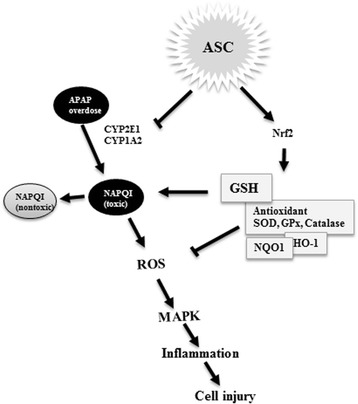Fig. 6.

Schematic of potential targets for omentum-derived ASC protection against APAP-induced hepatotoxicity. APAP overdose is metabolized by CYP2E1 and CYP1A2 to form the toxic metabolite NAPQI, which rapidly consumes intracellular GSH and causes ROS generation followed by the activation of the MAPK pathway, leading to inflammation and cell death. However, omentum-derived ASCs suppress CYP2E1 and CYP1A2 activity and activate Nrf2 expression to reduce the formation of the toxic metabolite NAPQI and subsequent ROS generation, resulting in attenuated APAP-induced toxicity. APAP: acetaminophen; ASC: adipose tissue-derived stem cells; CYP2E1: cytochrome P450 subfamily 2E1; CYP1A2: cytochrome P450 subfamily 1A2; NAPQI: N-acetyl-p-benzoquinoneimine; GSH: glutathione; ROS: reactive oxygen species; MAPK: mitogen-activated protein kinases; Nrf2: NF-E2-related factor 2; SOD: superoxide dismutase; GPx: glutathione peroxidase; NQO1: NADPH quinone oxidoreductase 1; HO-1: heme oxygenase-1
